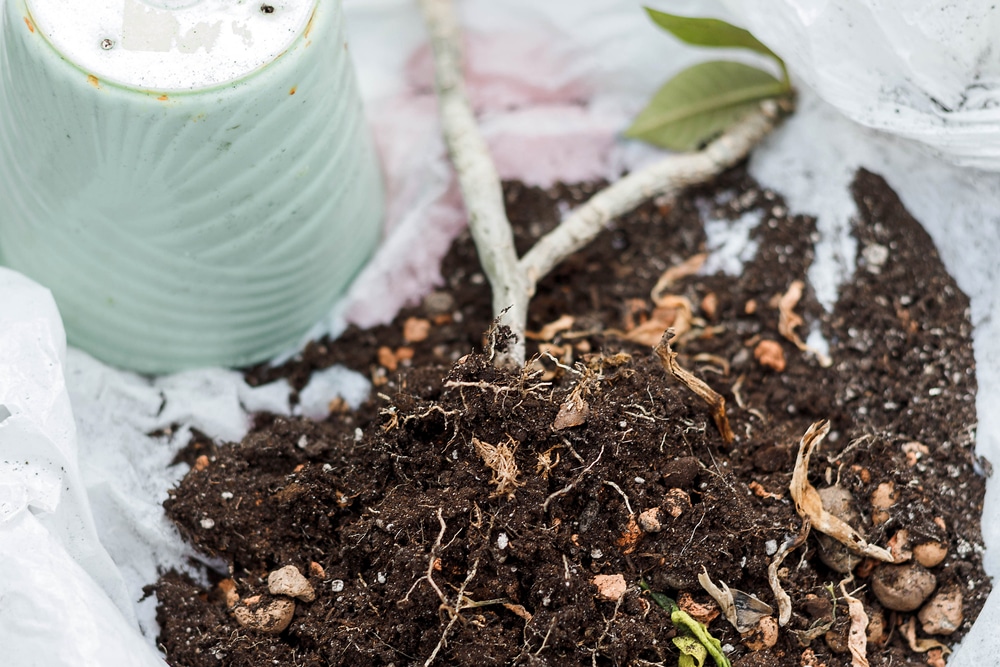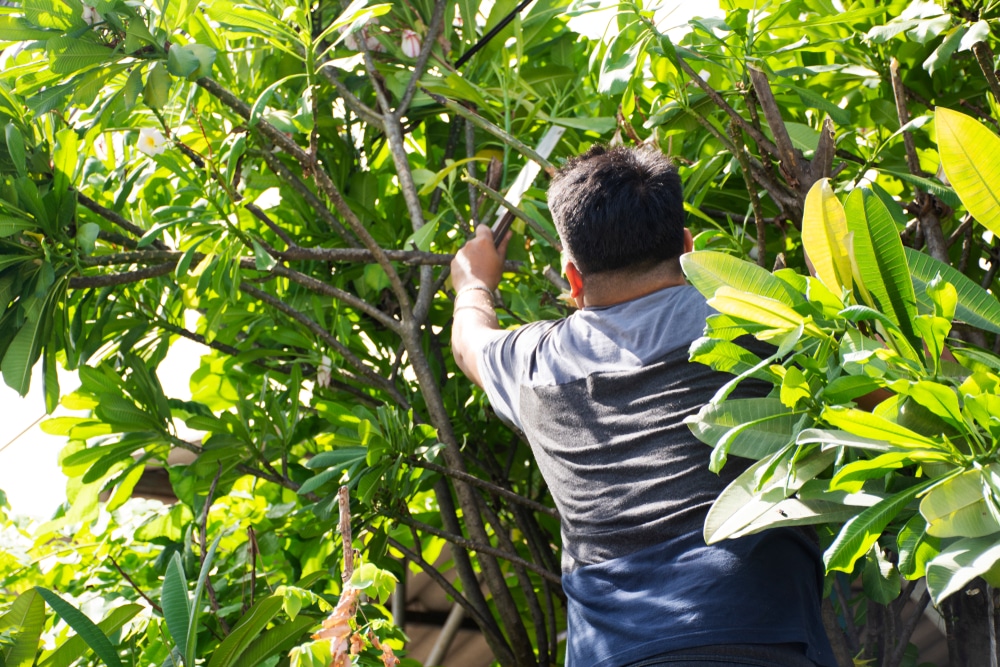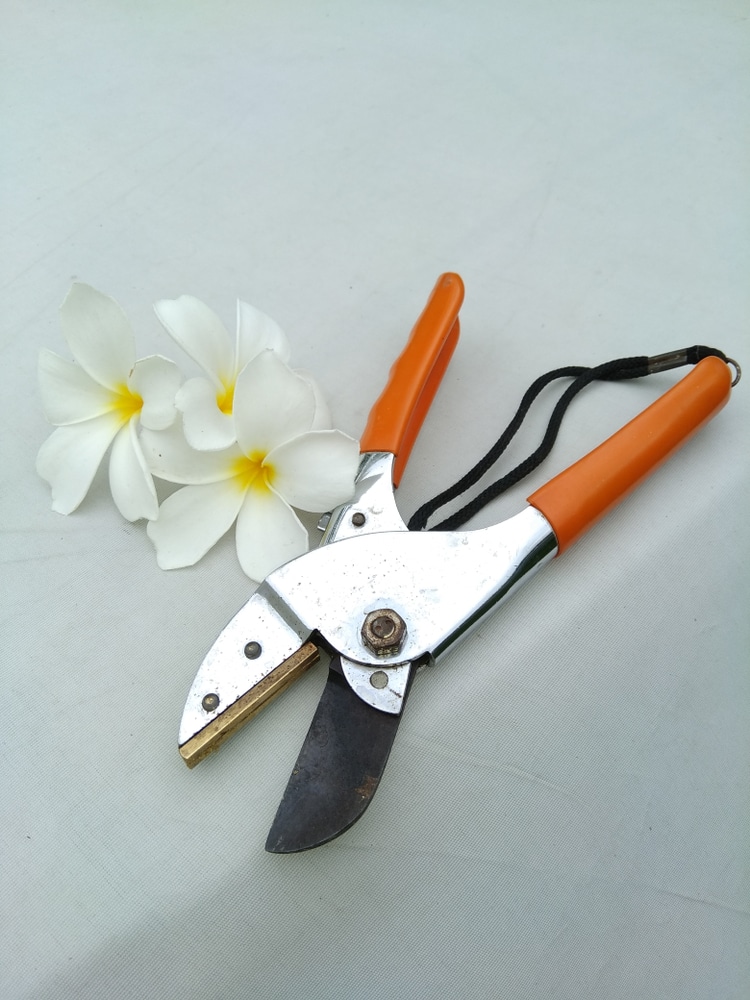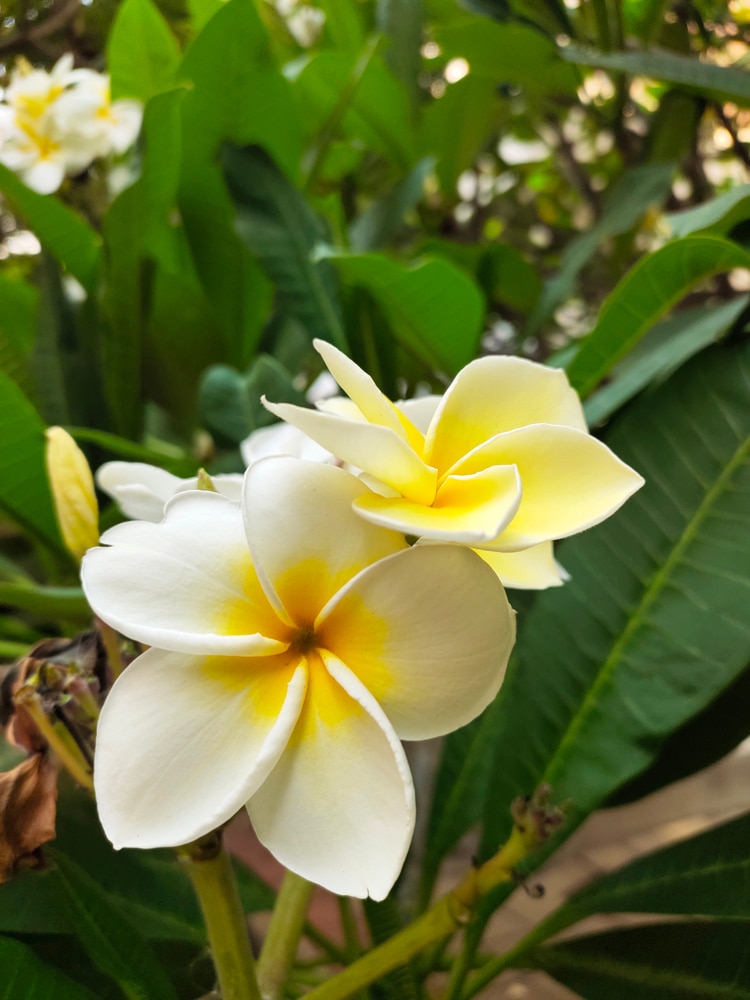Known for its extraordinarily showy and fragrant blooms, plumeria is a broadly crowned tropical tree that can make a real statement in the landscape.
These plants are hardy in frost-free climates, but they can also grow in cooler locations by growing them in containers and bringing them indoors during the winter.
If you are interested in trees, you’ll also want to learn proper techniques for trimming arborvitae trees.

Characteristics
The small genus Plumeria contains around seven species that are native to the subtropical and tropical regions of the Americas. Also commonly called Frangipani, it thrive in consistently warm climates, with more tropical conditions producing the best growth. Frangipani plants also perform well growing in containers.
Frangipani’s are small trees that grow to be around 20 feet tall at maturity. As they grow they eventually develop into a vase-like form. Only the branch ends of the greenish-gray, sausage-like branches fill with green and oval 12-inch deciduous leaves. The branches are relatively weak and soft, easily breaking.
For plumeria plants, it’s all about the blooms. Flowers start forming in early summer through late fall, with clusters filling the ends of branch tips. The flower is quite showy and fragrant with the waxy blooms that form into a pinwheel-shape. In fact, the eye-catching plumeria blooms are utilized in making Hawaiian leis.
If the flowers get pollinated by moths, butterflies, or other pollinators, the tree will eventually produce 6- to 12-inch long, green seed pods. As the seed pods mature, they turn brown, split open, and reveal the paper-like seeds. You can either use seeds or cuttings to propagate additional plants.

How to Propagate
If you don’t have a Frangipani plant, you can easily grow your own from a cutting (hopefully you have a friend with one). Cuttings are the quickest method to getting your desired result: a flowering plant. If you don’t have a friend who can give you one, many online vendors also sell them.
If you have more patience, you can also try growing from seed. Seeds planted in ideal conditions tend to have high germination rates. Just note that if you are propagating from seed, it may take up to three to five years before you it produces its first flowers.
One of the problems with growing from seed is that you may not know exactly what color flower you may get. Plumeria flowers can be found in various colors, including white, red, pink, yellow, and bicolor. However, if various plants grow in the same general location and produce different colored flowers, then you won’t know what color flowers your seed-grown Frangipani will ultimately produce. In fact, it’s possible it was pollinated with pollen from another colored flower, and the ultimate result might be a bicolored bloom.

Propragating Through Cuttings
Planting and growing cuttings is relatively basic. Best of all, you don’t have to be a gardening expert to experience success with this tropical beauty. The biggest threat after you plant your cuttings is watering too much and not using soil with good drainage.
Best Time
It’s best to take a cutting during the warmer months of spring or the summer. If you live in warmer climate with warm winter weather, you can propagate year-round.
Plumeria plants go through a dormant stage during wintertime when their growth slows. During this time, it drops its foliage and becomes dormant until springtime. This is especially true for those that are raised in climates where winter brings cooler temperatures.
Taking a cutting during when it is dormant leads to a slower propagation and may lead to failure for the plant to root.

Ideal Size
You can use cuttings from the branch tips or hardwood to propagate.
For branch tips, the tip will still be bright green with immature growth and can easily be snipped from the plant. It’s best to plant these branch tips soon after separating them from the mother plant. The ideal size for branch tip cuttings is usually around 5 inches long. About 5 inches from the branch, you will likely see a transition to older hardwood as the branch takes on a greenish-gray coloration.
Hardwood cuttings may be a foot long or longer and may contain larger branched sections making the entire fragment several feet tall. When using a large, multi-branched cutting, you have the satisfaction of an instantaneous small tree-like plant.
However, if you will be using a hardwood fragment, make sure you allow the cut end to dry and scab over for three or four days before you plant it. Place it in an area out of the full sun that receives good air circulation. Once the cut end heals over, you may plant it.

Tips for Pruning Your Plumeria
Hand clippers are sufficient for pruning green immature growth from branch tips. However, you may need loppers to cut off larger and thicker branches of old-growth.
If you desire to grow a thick and bushy plumeria, you’ll need to care for your tree by pruning it every spring. This is a great time to take cuttings that you need to remove from the mother plant anyways and plant them.
You can cut the branch anywhere along long branches or at a cross-section where multiple branches are growing. However, if you plan to grow a larger, multi-branched section, make sure the main branch supporting the plant is long enough. Remember, you’ll have to plant enough of the branch deep enough in the soil, so the fragment remains upright and doesn’t topple over because it’s too top-heavy.
Before actually taking your cuttings, make sure you use clean pruning tools. This will prevent the transfer of unwanted pests or diseases to your plant. Sanitizing your tool’s blades is as easy as wiping them off with rubbing alcohol. Also, some people are allergic to the milky sap, so it’s a good idea to wear gloves when you are trimming the branches.
If you are pruning from a tall tree, we recommend using long pole hedge trimmers and if you are trimming from a small tree, save yourself some effort by using a cordless pruner.

Planting Tips
Make sure to select a container that has bottom drainage to prevent soggy conditions. Improperly drained soil may lead to root rot, which occurs with pots without bottom drain holes or heavy potting soil that retains too much water.
You can grow your cuttings in any type of container. That being said, soil in porous materials like terra cotta dries out faster than soil in plastic pots. Once the root system establishes itself, plumeria plants are relatively drought-tolerant.
Use a fertile, well-drained soil in the containers like a rich, lightweight potting mix. Many times, straight potting soil is too heavy and tends to retain too much water. However, you can lighten the potting soil mix by amending about half of the mixture with vermiculite or sterile sand.
Whether planting branch tips or a larger hardwood fragments, always plant the cut end into the potting mix.
If you are planting a branch tip that is around 5 inches long, plant about 2 inches of the end in the soil. Water the potting mix.
If you are planting a larger cutting or section containing multiple branched sections, you’ll need a larger container like a 3- to 5-gallon. You’ll also need to plant about 3- to 6-inches of the branch’s cut end into the soil. Firm up the soil up around the cutting’s base so that it will not topple over.

For larger cuttings, you may also need to insert a stake into the pot and use it to keep them upright in the pot. Use something flexible that won’t tear into the cutting like pantyhose or survey tape, and tie it around the cutting and the stake. Once it has rooted and becomes established, you can remove the stake.
You can also plant larger cuttings directly in the landscape, so they are growing in their permanent location. Select an area situated in full sun and has soil that drains well and doesn’t puddle with water. Plant enough of the branch into the soil so it remains upright, and use a stake to help stabilize the cutting if needed.

How to Grow from Seed
Despite their showy and exotic good looks, plumeria plants propagate quite easily from seeds, and you don’t have to be a master gardener to grow healthy plants successfully. When seed pods split open, they reveal many light-colored, papery-thin seeds packed together. Only when the seed pod splits open are the seeds fully ripe and ready for propagating.
Use a seed-starting tray or small, 4-inch containers that drain and fill with a lightweight potting mix. Once filled, water the soil to settle it, which helps to keep the seed in place. Next, plant the seed, covering them with a thin 1/8-inch layer of soil. Mist the top of the soil with water to moisten the seed.
Seeds germinate the quickest when outdoor conditions are warm and sunny. When conditions are cooler and shadier, germination slows. So, place the containers in an outdoor location situated in full sun. You should see the seeds begin sprouting in seven to 14 days.

Care Guide
Plumeria are easy to care for plants and are relatively maintenance-free, once established in the planting site or container. Growing them in their preferred conditions produce healthy and problem-free growth.
Sun Requirements
Regardless of whether you are caring for plumerias in the landscape or containers, they’ll grow the fastest in full sun. Although they are tolerate some degree of shade, they will grow slower if they receive less light.
If you are taking care of plumerias in pots and you regularly experience frosts and freezes during winter, you’ll need to bring the plant into a bright and warm and sheltered location for protection. These are tropical plants that won’t survive conditions that are too cold.
If you are bringing it indoor, you’ll need to situate the Frangipani plant in an indoor location receiving bright light. A sunny indoor room works well, as does placing the container near a south-facing window. Windows on the south side of the house receive the most amount of natural sunlight and warmth.

Fertilizer Requirements
Whether you are caring for your cuttings in containers or planted it directly in the landscape, they’ll need periodic feedings. In both instances, wait until new growth starts appearing in spring before you apply fertilizer.
Growing in Containers
For plumerias grown in containers, use a general-purpose, water-soluble blend applied according to package directions. You can apply the fertilizer at the same time you water, watering until it runs from the bottom drain holes. Feed it around every six weeks through the growing season.
However, stop fertilizing the plumeria in fall when the plant goes into dormancy. During this time, the plant stops its active growth, so there’s no need to continue fertilizing. Once spring arrives and it starts growing again, you can restart the feedings.
Additionally, many types of potting mixes contain a slow-release fertilizer incorporated into the soil. The product slowly breaks down when you water, feeding the roots of your plumeria. This alleviates the need for additional fertilizer applications. Slow-release pellets usually continue working for three months before you’ll need to reapply the product.

Growing in the Landscape
If you planted your cutting directly in the landscape, you could use a general-purpose granular blend like a 1-3-1; you can check out our recommended plumeria fertilizers here. Follow package directions on amounts and spread evenly under the Frangipani’s canopy, being sure not to butt the product against the trunk to prevent burning. Once applied, water the fertilizer into the soil.
Feed plumeria growing in the landscape every month to six weeks during the growing season while the plant is actively growing. Cease fertilizing in fall when it begins going through its dormant stage.

Watering Frequency
Once the roots establish themselves into the planting site, plumeria are relatively tolerant to drought conditions. They aren’t demanding when it comes to water and are forgiving if you forget your watering chores for several weeks.
Watering Cutting in Pots
When it comes to watering newly planted cuttings, water immediately after planting and if growing in containers, water until it runs from the pot’s bottom drain holes. New roots should establish themselves into the container’s soil in about eight weeks.
Continue watering container-grown plumeria weekly, depending on your local weather conditions. Feel the soil and if the top several inches are dry, apply water. Plumeria won’t tolerate soggy conditions, so make sure the soil doesn’t remain saturated continuously, or you may have problems with rot. If the bottom of the cutting starts feeling mushy and collapsing, it has developed rot and will most likely die.
Watering Plants Started from Seeds
When propagating with seeds, it’s necessary to keep the soil moist, not soggy for the seeds to germinate and grow properly. Since it can take up to two weeks and sometimes even longer for seeds to germinate, you don’t want a heavy flush of water dislodging them from the soil.
Using a spray bottle filled with water and misting the soil until it’s saturated keeps the seeds securely in place and well-watered. Depending on local weather conditions, you may have to mist the seeds daily. If you notice the top of the soil starts to dry out, apply water. However, like cuttings, you don’t want to keep the soil soggy, or the seeds will rot and never germinate.

Watering Plumerias Planted in the Landscape
Until the cuttings establish themselves in the landscape in about two months, water deeply several times each week. Since established plumeria are relatively drought-tolerant, you will probably only need to water once per week once the plants have taken root in their permanent location.
Plumeria roots are relatively shallow, so it won’t take much water to thoroughly drench the entire root system. Of course, if your outdoor conditions are rainy, you won’t need to carry out your water chores. Plumeria plants often receive an adequate amount of water from outdoor conditions, cutting down the need for supplemental applications.


This is one of the best articles on this topic so far. Just the right amount of detail, very helpful.
thank you. This article was the most complete and all around informative piece I’ve come across. I don’t feel the need to continue researching plummerias any further.
I live in central Texas and received a Plumeria plant about 2′ tall. If I plant it in the ground and we get an unexpected hard freeze or very cold conditions, can I wrap the plant or protect the root system?
Yes! Throw a burlap sack over it if necessary to protect it from the cold.
Approximately 12 years ago I received an about 6 inch cutting of Plumaria. I live in Nebraska and have to bring the now 9/10 feet tall bush into the house and leave it to become dormant in the winter. The main branch only has top leave growth and no side shoots for the last 4 feet. I would like to cut that off and try to root it as it’s too unwieldy to carry in. Can I just cut it off and propagate it?
I have successfully done this once, last year. Both the parent Plant and the cutting are doing well. After reading this post, I feel fairly confident I can top off my 7 year old trees.
Cuttings grow easily from when they come into leaf but need to be taken before mid summer to get certain success.
My plant looks bad. The tips looks like rotting cigars. Too much water? If so, what can I do to get it back to looking great again?